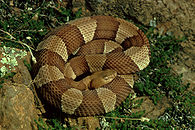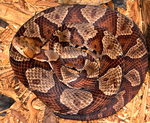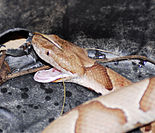Eastern copperhead: Difference between revisions
Undid revision 273591658 by 204.116.243.60 (talk) due to vandalism |
No edit summary |
||
| Line 44: | Line 44: | ||
}} |
}} |
||
:'''''Common names''': copperhead |
:'''''Common names''': copperhead, chunk head, death adder, (dry-land) moccasin,<ref name="W&W57">Wright AH, Wright AA. 1957. Handbook of Snakes. Comstock Publishing Associates. (7th printing, 1985). 1105 pp. ISBN 0801404630 .</ref> [[Agkistrodon contortrix#Common names|more]].'' |
||
'''''Agkistrodon contortrix''''' is a [[venomous snake|venomous]] [[Crotalinae|pitviper]] [[species]] found in [[North America]]. Five [[subspecies]] are currently recognized, including the nominate subspecies described here.<ref name="ITIS">{{ITIS|ID=174296|taxon=''Agkistrodon contortrix''|year=2006|date=28 November}}</ref> |
'''''Agkistrodon contortrix''''' is a [[venomous snake|venomous]] [[Crotalinae|pitviper]] [[species]] found in [[North America]]. Five [[subspecies]] are currently recognized, including the nominate subspecies described here.<ref name="ITIS">{{ITIS|ID=174296|taxon=''Agkistrodon contortrix''|year=2006|date=28 November}}</ref> |
||
Revision as of 12:26, 27 February 2009
| Agkistrodon contortrix | |
|---|---|

| |
| Scientific classification | |
| Kingdom: | |
| Phylum: | |
| Subphylum: | |
| Class: | |
| Order: | |
| Suborder: | |
| Family: | |
| Subfamily: | |
| Genus: | |
| Species: | A. contortrix
|
| Binomial name | |
| Agkistrodon contortrix Linnaeus, 1766
| |
| Synonyms | |
| |
Agkistrodon contortrix is a venomous pitviper species found in North America. Five subspecies are currently recognized, including the nominate subspecies described here.[3]
Description

Adults usually grow to a total length of 50-95 cm, although some may exceed 1 m. Males are usually larger than females. The maximum length reported for this species is 134.6 cm for A. c. mokasen (Ditmars, 1931). Brimley (1944) mentions a specimen of A. c. mokasen from Chapel Hill, North Carolina, that was "four feet, six inches" (137.2 cm), but this may have been an approximation. The maximum length for A. c. contortrix is 132.1 cm (Conant, 1958).[4]
The body is relatively stout and the head is broad and distinct from the neck. Because the snout slopes down and back, it appears less blunt than that of the cottonmouth, A. piscivorus. Consequently, the top of the head extends further forward than the mouth.[5]
The scalation includes 21-25 (usually 23) rows of dorsal scales at midbody, 138-157 ventral scales in both sexes and 38-62/37-57 subcaudal scales in males/females. The subcaudals are usually single, but the percentage thereof decreases clinally from the northeast, where about 80% are undivided, to the southwest of the geographic range where as little as 50% may be undivided. On the head there are usually 9 large symmetrical plates, 6-10 (usually 8) supralabial scales and 8-13 (usually 10) sublabial scales.[4]
The color pattern consists of a pale tan to pinkish tan ground color that becomes darker towards the midline, overlaid with a series of 10-18 (13.4) crossbands. Characteristically, both the ground color and crossband pattern are pale in A. c. contortrix. These crossbands are light tan to pinkish tan to pale brown in the center, but darker towards the edges. They are about 2 scales wide or less at the midline of the back, but expand to a width of 6-10 scales on the sides of the body. They do not extend down to the ventral scales. Often, the crossbands are divided at the midline and alternate on either side of the body, with some individuals even having more half bands than complete ones. A series of dark brown spots is also present on the flanks, next to the belly, and are largest and darkest in the spaces between the crossbands. The belly is the same color as the ground color, but may be a little whitish in part. At the base of the tail there are 1-3 (usually 2) brown crossbands followed by a gray area. In juveniles, the pattern on the tail is more distinct: 7-9 crossbands are visible, while the tip is yellow. On the head, the crown is usually unmarked, except for a pair of small dark spots, one near the midline of each parietal scale. A faint postocular stripe is also present; diffuse above and bordered below by a narrow brown edge.[5]
Several aberrant color patterns for A. c. contortrix, or populations that intergrade with it, have also been reported. In a specimen described by Livezey (1949) from Walker County, Texas, 11 of 17 crossbands were not joined middorsally, while on one side three of the crossbands were fused together longitudinally to form an continuous undulating band, surmounted above by a dark stripe that was 2-2.5 scales wide. In another specimen, from Lowndes County, Alabama, the first three crossbands were complete, followed by a dark stripe that ran down either side of the body, with points of pigment reaching up to the midline in six places but never getting there, after which the last four crossbands on the tail were also complete. A specimen found in Terrebonne Parish, Louisiana by Ernest A. Liner, had a similar striped pattern, with only the first and last two crossbands being normal.[5]
Common names
Copperhead (snake), chunk head, death adder, highland moccasin, (dry-land) moccasin, narrow-banded copperhead, northern copperhead, pilot snake, poplar leaf, red oak, red snake, southeastern copperhead, white oak snake,[2] American copperhead,[6] southern copperhead,[5] cantil cobrizo (Spanish).[3]
Geographic range
Found in the United States in the states of Texas, Oklahoma, Kansas, Missouri, Arkansas, Louisiana, Mississippi, Alabama, Georgia, Florida, South Carolina, North Carolina, Tennessee, Kentucky, Virginia, West Virginia, Illinois, Indiana, Ohio, Iowa, Pennsylvania, Maryland, New Jersey, Delaware, New York, Connecticut and Massachusetts. In Mexico it occurs in Chihuahua and Coahuila. The type locality is "Carolina." Schmidt (1953) proposed that the type locality be restricted to "Charleston, South Carolina."[1]
Habitat
Within its range it occupies a variety of different habitats. In most of North America it favors deciduous forest and mixed woodlands. It is often associated with rock outcroppings and ledges, but is also found in low-lying swampy regions. In the states around the Gulf of Mexico, however, this species is also found in coniferous forest. In the Chihuahuan Desert of west Texas and northern Mexico, it occurs in riparian habitats, usually near permanent or semipermanent water and sometimes in dry arroyos.[4]
Conservation status
This species is classified as Least Concern (LC) on the IUCN Red List of Threatened Species (v3.1, 2001).[7] Species are listed as such due to their wide distribution, presumed large population, or because it is unlikely to be declining fast enough to qualify for listing in a more threatened category. The population trend is stable. Year assessed: 2007.[8]
Behavior

Like all pit vipers, A. contortrix is an ambush predator: it takes up a promising position and waits for suitable prey to arrive. In the southern United States, they are nocturnal during the hot summer months, but are commonly active during the day during the spring and fall.
Like most North American viperids, these snakes prefer to avoid humans and, given the opportunity, will leave the area without biting. However, unlike other viperids they will often "freeze" instead of slithering away, and as a result many bites occur from people unknowingly stepping on or near them.[9] This tendency to freeze likely evolved because of the extreme effectiveness of their camouflage. When lying on dead leaves or red clay they can be almost impossible to notice. They will frequently stay still even when approached closely, and will generally strike only if physical contact is made.
Feeding
Roughly 90% of its diet consists of small rodents, such as mice and voles. They have also shown fondness for large insects and frogs, and though highly terrestrial, have been known to climb trees to gorge on emerging cicadas.
Reproduction
A. contortrix breeds in late summer, but not every year: sometimes a female will produce young for several years running, then not breed at all for a time. They give birth to live young about 20 cm long: a typical litter is 4 to 7, but it can be as few as one or as many as 20. Their size apart, the young are similar to the adults, but lighter in color, and with a yellow-marked tip to the tail, which is used to lure lizards and frogs.
Venom
Although venomous, these snakes are generally non-aggressive and bites are almost never fatal. Copperhead venom has an estimated lethal dose of around 100mg, and tests on mice show its potency is among the lowest of all pit vipers, though slightly stronger than that of its close relative, the cottonmouth. The bite of a cottonmouth is more serious, however, as they have a much larger venom yield than a copperhead. Copperheads often employ a "warning bite" when stepped on or agitated and inject a relatively small amount of venom, if any at all. "Dry bites" involving no venom are particularly common with the copperhead, though all pit vipers are capable of a dry bite.
Bite symptoms include intense pain, tingling, throbbing, swelling, and severe nausea. Damage can occur to muscle and bone tissue, especially when the bite occurs in the outer extremities such as the hands and feet, areas in which there is not a large muscle mass to absorb the venom. A bite from any venomous snake should be taken very seriously and immediate medical attention sought, as allergic reaction and secondary infection are always possible.
The venom of the Southern copperhead has been found to hold a protein called "Contortrostatin" that halts the growth of cancer cells and also stops the migration of the tumors to other sites. It will probably be ten or more years before contortrostatin is used in practical treatment but it has shown to be a novel anti cancer drug in the Lab. Specialized Venom's of Seneca South Carolina milk copperheads for their venom which is used in research Labs through out the U S A.
Although technically the antivenin CroFab could be used to treat an envenomation, it is usually not administered for copperheads, as the risk of complications of an allergic reaction to the treatment are greater than the risk from the snakebite itself in most cases. The very few reported deaths from copperhead bites all involved multiple snakes. Pain management, antibiotics, and medical supervision in the case of complications is usually the course of action.[1]
Subspecies
| Subspecies[3] | Taxon author[3] | Common name[5] | Geographic range[5] |
|---|---|---|---|
| A. c. contortrix | (Linnaeus, 1766) | Southern copperhead | The United States, in the lower Mississippi Valley and the states bordering the Gulf of Mexico, from eastern Texas and southeastern Oklahoma to southern Illinois. On the South Atlantic Coastal Plain from the Florida panhandle to South Carolina. |
| A. c. laticinctus | Gloyd & Conant, 1934 | Broad-banded copperhead | The United States, from south-central Texas (Victoria to Frio counties), north through central Oklahoma to the extreme south of Cowley County, Kansas. |
| A. c. mokasen | Palisot de Beauvois, 1799 | Northern copperhead | The United States, in southern Illinois, extreme northeastern Mississippi, northern Alabama, northern Georgia northeast to Massachusetts, the Appalachian Mountain region and associates plateaus. |
| A. c. phaeogaster | Gloyd, 1969 | Osage copperhead | The United States, in eastern Kansas, extreme southeastern Nebraska and a large part of Missouri. |
| A. c. pictigaster | Gloyd & Conant, 1943 | Trans-pecos copperhead | The United States, in western Texas from the vicinity of the Pecos and Devils rivers to the counties of Jeff Davis and Presidio. Mexico, in northern Chihuahua and Coahuila. |
See also
- List of crotaline species and subspecies
- Crotalinae by common name
- Crotalinae by taxonomic synonyms
- Snakebite
Gallery
| Habitats | Isolated | Closeups |
|---|---|---|

|

|
File:A03 2618 640x427.JPG |
| Broad-banded copperhead | Southern Copperhead | St. Louis Zoo |

|

|

|
| Copperhead crossing river in Virginia Beach |
Southern Copperhead in Covington, Georgia, at Bert Adams Scout Reservation |
Northern copperhead |

|

|

|
| Southern copperhead, near a cicada (in Arkansas) |
Southern copperhead consuming cicada (Arkansas) |
Southern copperhead close up (in Arkansas) |
References
- ^ a b McDiarmid RW, Campbell JA, Touré T. 1999. Snake Species of the World: A Taxonomic and Geographic Reference, vol. 1. Herpetologists' League. 511 pp. ISBN 1-893777-00-6 (series). ISBN 1-893777-01-4 (volume).
- ^ a b Wright AH, Wright AA. 1957. Handbook of Snakes. Comstock Publishing Associates. (7th printing, 1985). 1105 pp. ISBN 0801404630 .
- ^ a b c d "Agkistrodon contortrix". Integrated Taxonomic Information System. 28 November.
{{cite web}}: Check date values in:|date=and|year=/|date=mismatch (help) - ^ a b c Campbell JA, Lamar WW. 2004. The Venomous Reptiles of the Western Hemisphere. Comstock Publishing Associates, Ithaca and London. 870 pp. 1500 plates. ISBN 0-8014-4141-2.
- ^ a b c d e f Gloyd HK, Conant R. 1990. Snakes of the Agkistrodon Complex: A Monographic Review. Society for the Study of Amphibians and Reptiles. 614 pp. 52 plates. LCCN 89-50342. ISBN 0-916984-20-6.
- ^ U.S. Navy. 1991. Poisonous Snakes of the World. US Govt. New York: Dover Publications Inc. 203 pp. ISBN 0-486-26629-X.
- ^ Agkistrodon contortrix at the IUCN Red List. Accessed 13 September 2007.
- ^ 2001 Categories & Criteria (version 3.1) at the IUCN Red List. Accessed 13 September 2007.
- ^ "Venomous Snakes". National Institute for Occupational Safety and Health. Retrieved on November 10, 2008.
Further reading
- Brimley CS. 1944. Amphibians and reptiles of North Carolina. Elon College, North Carolina, Carolina Biol. Supply Co., reprinted from Carolina Tips, 1939-43: 1-63.
- Conant R. 1958. A field guide to reptiles and amphibians of the United States and Canada east of the 100th meridian. Boston, Massachusettes, Houghton, Mifflin Co.: i-xv, 1-366.
- Livezey RL. 1949. An aberrant pattern of Agkistrodon mokeson austrinus. Herpetologica, 5: 93.
External links
- Agkistrodon contortrix at the Reptarium.cz Reptile Database. Accessed 9 August 2007.
- Copperhead Snakes - bites, ecology & pictures. Accessed 10 October 2008.
- Reclining With Vipers at Robert Winkler's homepage. Accessed 15 June 2007.
- Copperhead - Agkistrodon contortrix at Herpnet.net, Reptiles and Amphibians of Iowa. Accessed 15 June 2007.
- A. c. contortrix image at Glades Herp. Accessed 9 August 2007.

